As a qualified builder and roofer, I should disclose that I really don’t like tile roofs.
They’re heavy, they’re porous and get heavier as they soak up water, they leak heat and dirt, they’re hard to install on, and sadly, as many people find out, water leaks lead to recriminations. But we have to deal with them, and rest assured there are good ways to do it. Read on for a guide to the finer details of installing solar panels on a tiled roof.
The Best Tile Roof I Ever Worked On
That was one we filled a skip with. I was on-site to move a solar hot water service while the roofers went about their work. 16 tons of broken masonry was thrown unceremoniously off the roof into the bin, and replaced with 1.2 tons of iron roof, plus extra insulation. Without the extra weight, the gutters could be fixed, and the eaves wouldn’t sag.
A work in progress. Shiny new roof, light in colour with fluffy insulation evident. This should be on this list for any significant renovation.
If You Want To Be Sure – Get A Site Visit
The prospect of a tiled roof is a great reason for a solar installer to do a site visit and positively identify what kind of tile you have. Why do they care? Mainly because you need to have spare tiles on hand before starting installation, but also because some profiles, like Spanish deep or super flat terracotta shingle may need extra extension brackets or even a completely different fixing such as a “hangar bolt”, which is drilled through instead of laying between tiles.
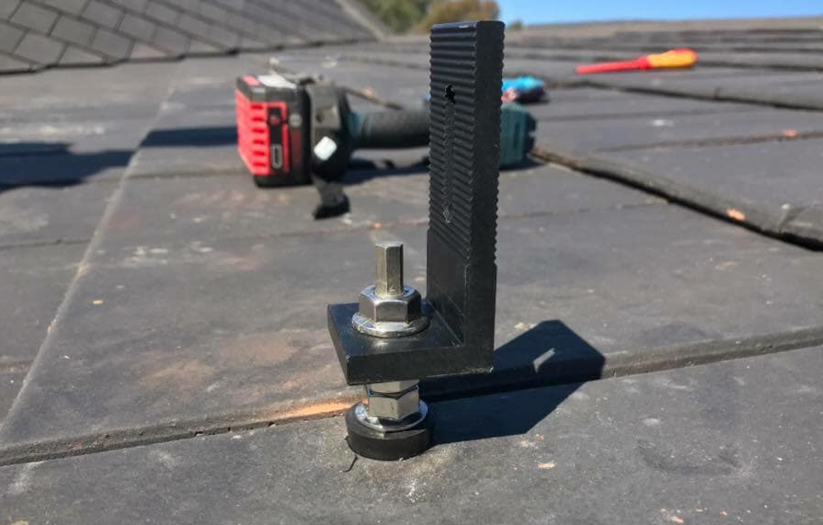
Sooky installers will go ashen-faced and shuffle away backwards if you have thin tiles or a slate roof. The gun tradesman will install hangar bolts and get on with it.
If you don’t have spares left over from the original build, the installer should be able to point you in the direction of a local salvage yard or tile supplier, because they’ve been to them before. They may be glazed terracotta (known in the solar industry as TERRORcotta) or concrete tiles, but either way there are some that are quite robust and many that are horribly brittle.
I have had first-hand experience with tiles that seem quite good. They handle foot traffic quite well during the framing and wiring stage of installation but as soon as we start marching the solar panels out, an extra 20kg per footfall breaks them at an alarming rate.
So, please make sure you have spare tiles available on install day.
What Did Tiles Ever Do To You, Anthony?
My most unbelievable job was terracotta on a two-storey house with a coastal outlook. Bear in mind it had a steep driveway and required we sling panels and lift them two at a time with a crane truck. Close to the limit at 9 metres reach and using a spotter to operate the crane just made it more fun.
Walking off the ladder at the back of the property was ok but the real killer was that as soon as you crossed the ridge to the side that cops the prevailing wind, the tiles were little better than chalk.
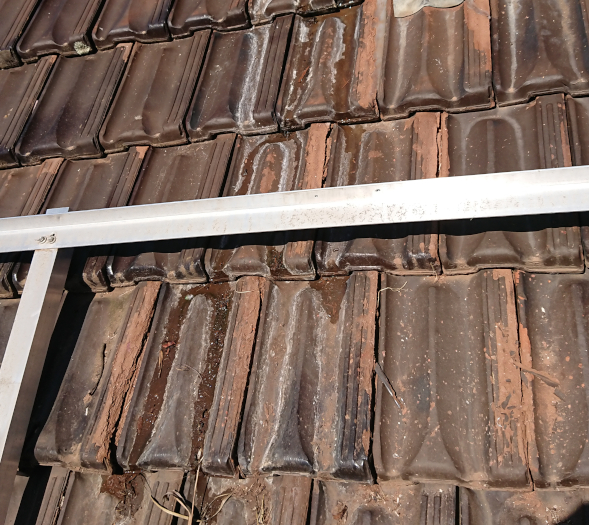
Many of these crumbly old bits of rubbish have been protected from the elements under a solar panel array for 9 years. The rest of the roof looked cleaner because the rain strike of individual droplets washes away the evidence of disintegration. Under the panels the fragments just sit on the high points. credit Solar Depot
Many people don’t realise clay tiles aren’t necessarily as well protected on the underside, and so they fret and disintegrate from the inside out. We used all the spares the customer had. The best approach for the work crew is to notice, examine and mark the tiles as they’re broken through the day. Once the job is finished you work back across the roof swapping them out.
If your spares are a different colour then they can be put under the solar panel array before the panels are laid, but otherwise I try to do them all at the end of the day. As for our horribly brittle coastal tile house, as I was trying to get off the roof for the last time I of course broke another tile.
I scurried across to swap the cracked tile with one that was under a lead flashing against a wall. That trick had been done before, so I had to choose carefully to find one that was intact (air conditioners and chimneys also often have good tiles hiding under flashings). The most comical part was that this process had to be repeated four times before I made it off the roof without the telltale crack of a tile failing underfoot. It was a long day.
Modifying Tiles The Right Way
The other thing often breaking tiles is rough workers using rough methods to create the clearance needed for tile brackets. For some profiles there is a pretty straightforward way to chip a piece of tile away with a hammer. It’s quick to do of course and not too far removed from the way tiles are “cut” to fit hips and valleys when they’re installed.
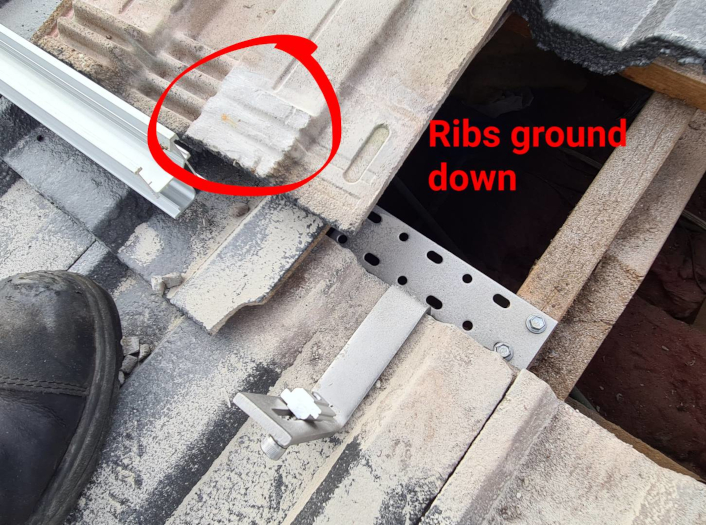
This was a relatively simple modification on a concrete tile. Credit: Me.
A better class of solar installer will use a grinder with a diamond wheel to make the required channel. It might mean both the top and bottom tile is ground out or has a lip cut off, but in any case, the workers involved should have a decent-quality respirator on. Dust diseases aren’t pretty.
This is the desired fit. The aim is to have the tile sit nicely back where it should be, even though you have a stainless steel bracket laid between them. I know there are hundreds of jobs in the wild where nothing has been ground, and they seem to have gotten away with it unless it’s a low pitch. But a low-pitch tile roof is an especially silly idea in the first place.
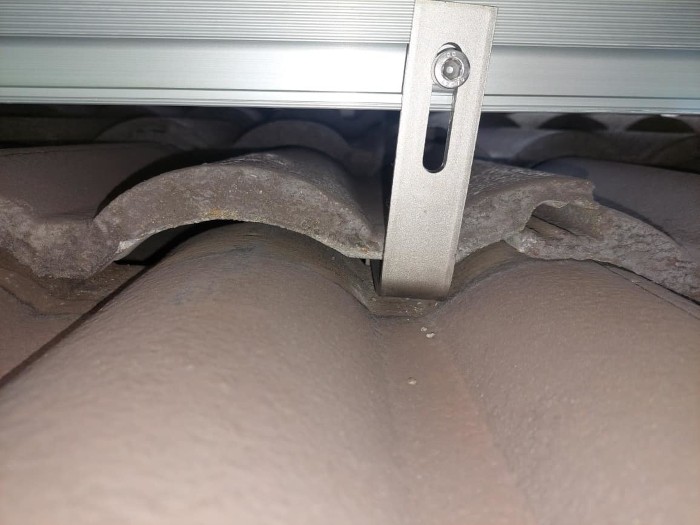
This is how it shouldn’t be done, yet it often doesn’t prove to be a problem.
Other Points To Consider
Terracotta tiles are kiln-fired and often aren’t consistent in size and shape, so they don’t always engage with the tile battens or each other very well. In contrast, solar panels are millimetre-perfect and will often show up sagging roofs, deviations in battens and other “organic” flaws tiles usually hide.
Hardwood battens can spilt and move – as can rafters supporting them, which your solar frame is screwed to. So, a roof restorer who is looking for cracked tiles and otherwise focusing on repointing hips and ridges may not notice more general issues with the tile placement on the battens, and everything being perfectly straight and true.
These are issues solar installers find frustrating – tiles don’t appear higgledy-piggledy until you put a straight edge across them and show up the flaws. Then everyone is a bit miffed at the appearance.
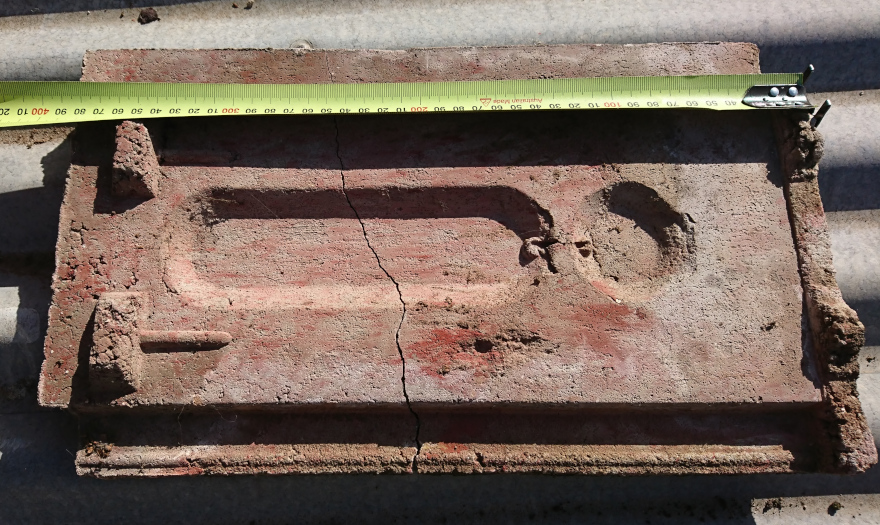
Clean break across the middle but you’d be surprised what roof sealant will do while you’re chasing far and wide for very old tiles.
The Riskiest Tiles
When installing tile brackets for solar framing, they often must be shimmed/packed up to clear the tile they sit over, while the tile that covers the bracket must be ground out to allow the tile to sit down in place over the bracket. Disturbing them in this process might mean you find they or the battens have been fretting and crawling.
The risk for solar installers is that the tile under the bracket can be cracked if somebody rests too much body weight or steps on the racking.
Cracked tiles can leak and are very hard to replace in this situation without totally disassembling the array. Depending on the amount of work involved and the extra foot traffic required, these leaks are sometimes best fixed not by tearing it all up, but simply by using the best quality polyurethane sealant (i.e. Sikaflex). I have worked on tile roofs without spare tiles and the broken ones end up glued back together, often quite successfully. They’re put at the bottom of the roof where they can be replaced later.
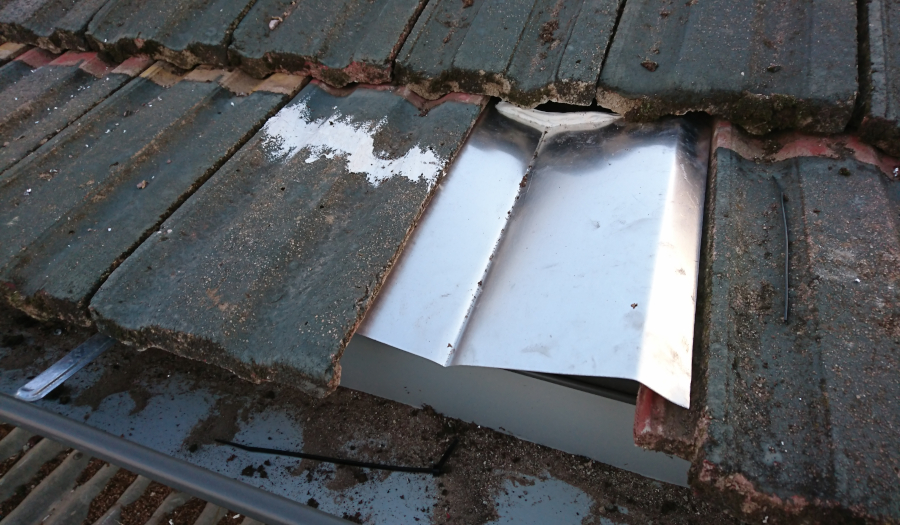
Needs must. Half a tube of Sikaflex and a modified metal isolator cover later…
Getting Wiring Through Tiles
Making a penetration in a tile roof can be managed in a few ways, and despite what you might think about the mechanical mounting of arrays, getting the wiring through can’t be done the same way.
AS/NZS 3000 prohibits running wiring within 50mm of a finished surface, not that it stopped many installers for many years. However, the rules state wiring must pass through the roof at right angles to it.
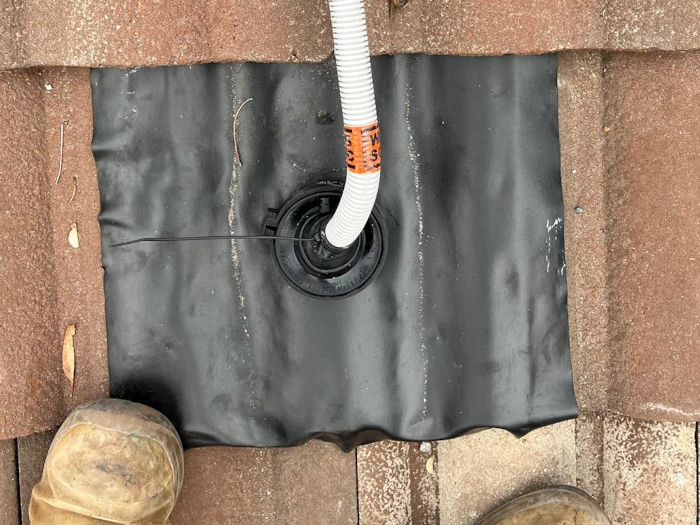
Full-sized flashing can be used over a cracked tile if running short.
Many installers will use a large EPDM flashing that covers or replaces an entire tile, and they’ll swear at anyone who dares try it another way.
My personal approach is to use a wet diamond holesaw to cut a neat hole, clean the tile and then glue a Dektite to the tile with polyurethane sealant like Sikaflex. This is the same style of stuff they use to make the windscreen a structural part of your car. Even roof and gutter silicone will work if it’s applied properly.
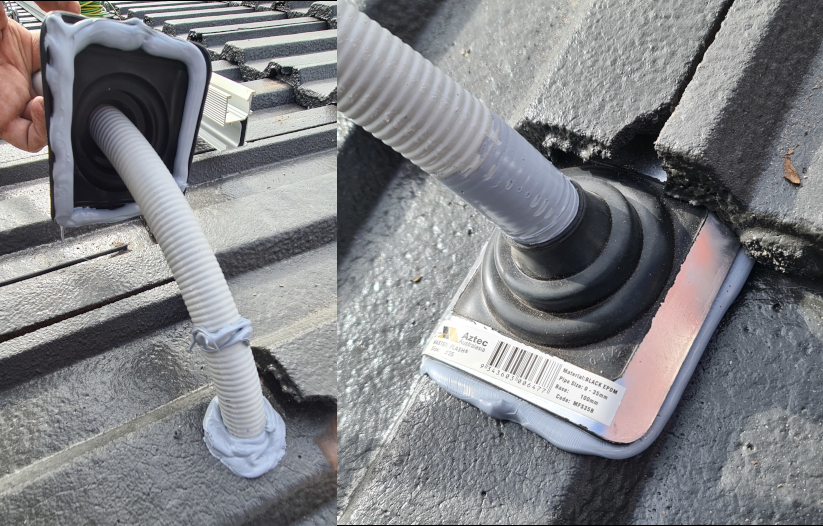
Red silicone flashings would be my preference but at least we got to use sikaflex here to bond this EPDM one down. Note the tile overlaps the edge to help make it mechanically waterproof and hold it down while the sealant goes off.
I’ve also seen a metal flashing used instead of a tile or, perhaps the best yet: a threaded bulkhead fitting. You must drill a neat hole. Once the hole is made, the gland fitting is installed and a nut wound on to secure it. This solution is mechanically strong and very well sealed, I would specify these cobalt ones if you’re after the best.
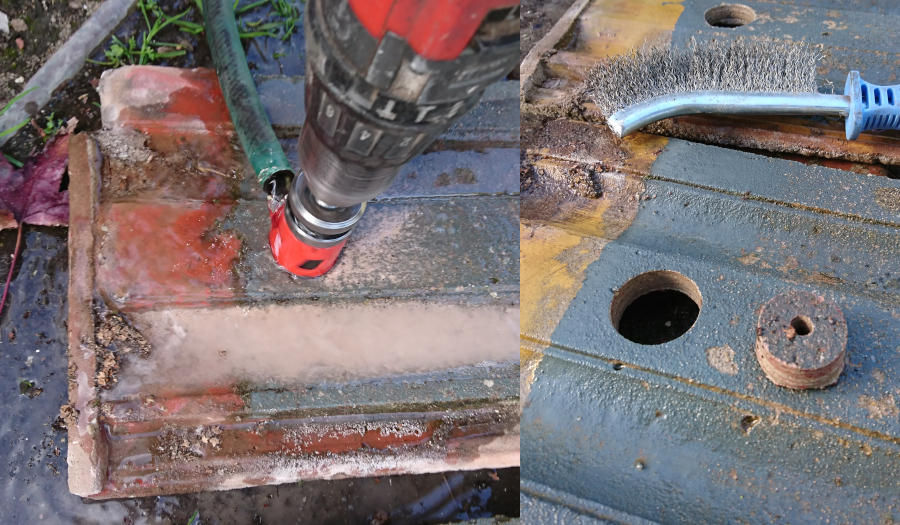
I find it’s best done wet. Dust control, tool life and, importantly, tile cleaning for good adhesion is important.
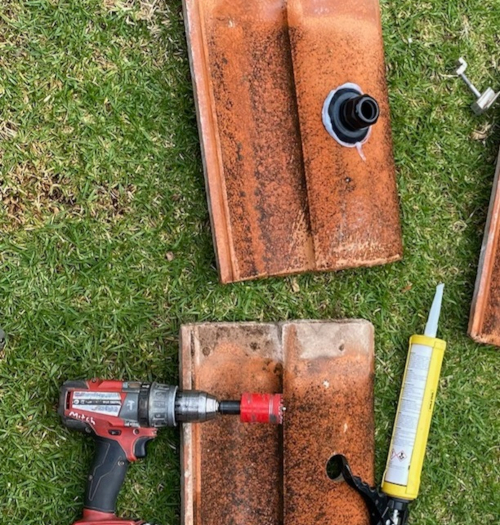
Cobalt gland – which is a bulkhead style fitting for really durable penetrations.
Other Issues With Solar On A Tiled Roof
The final thing I should mention about tile roofs is they sometimes preclude you from having solar panels unless you’re willing to have the ridges and hips relaid. The real pain with tiles is the cappings are bedded with sand and cement, then pointed with yet more inflexible cement render. Modern formulations are much better, but the point remains, you can’t get a bracket near the edges of the roof plane, and so it makes the roof smaller in solar terms.
If you’re planning on having the roof restored, it can be beneficial to have the work staged so cleaning and painting are done before the solar installation (including some spare tiles), and the ridges and hips are repointed afterwards so that work isn’t disturbed by solar installers kicking tiles. I’ve seen it done both ways, and if you raise it with your installer, they’ll at least know you have the best outcome in mind.
The most frugal tile owner I ever met made himself a tiny crane, winched his tiles off the roof four at a time, and hand-painted them on the ground before swapping them back onto the house. I think he could get a couple of dozen of them done in a weekend if the mood struck him.
Be Aware Of Roof Painters
Some of these people are not very bright. They will lay tools on the array, paint the isolators shut or walk across the solar panels. The ones that get in the most trouble don’t mask the panels off with drop sheets. Once they’ve covered the glass with paint overspray, it’s time to call your insurance company because no amount of cleaning will help.
If you get the paint off, it will likely damage the anti-reflective coating on the glass, and the trauma involved with scrubbing & pressure washing will have either caused invisible micro-cracks or injected water into the edges of the panels causing earth leakage issues.
Tiles Aren’t All Bad
They’re quiet when it’s raining, I suppose. Most electricians will tell you they’re easy to access and run new cables at least, so that can save time and money when you need a new induction stove circuit. And, of course, thieves love getting into a house without breaking windows too.

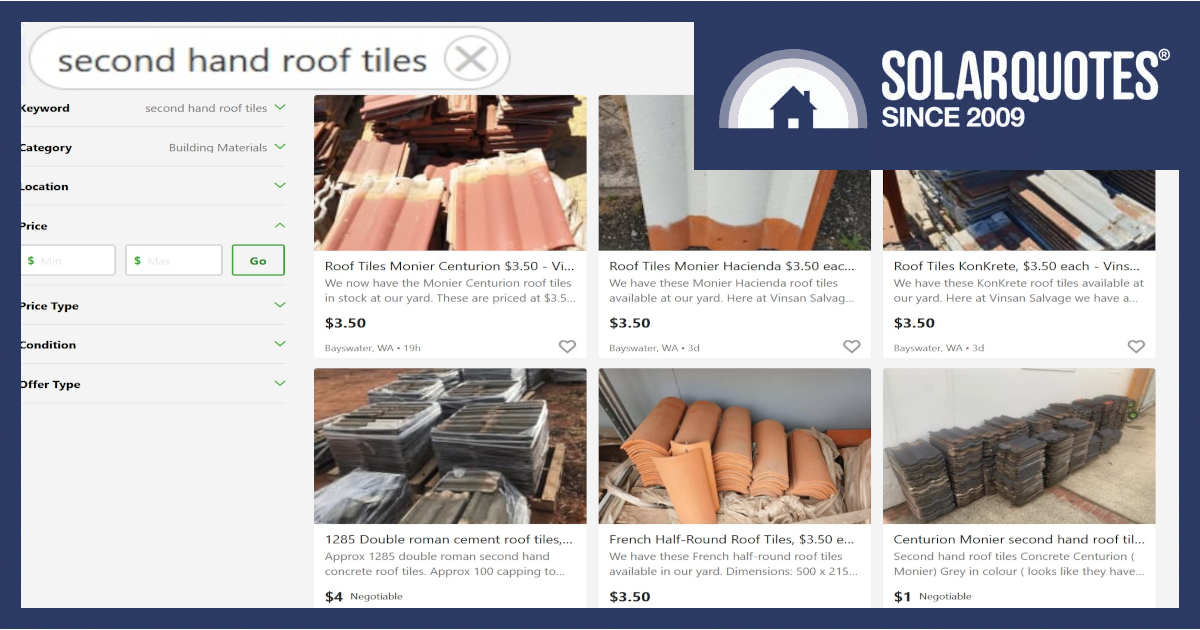
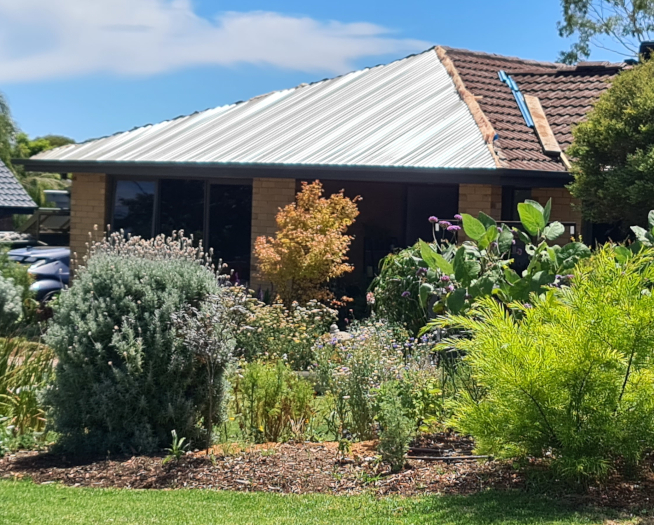
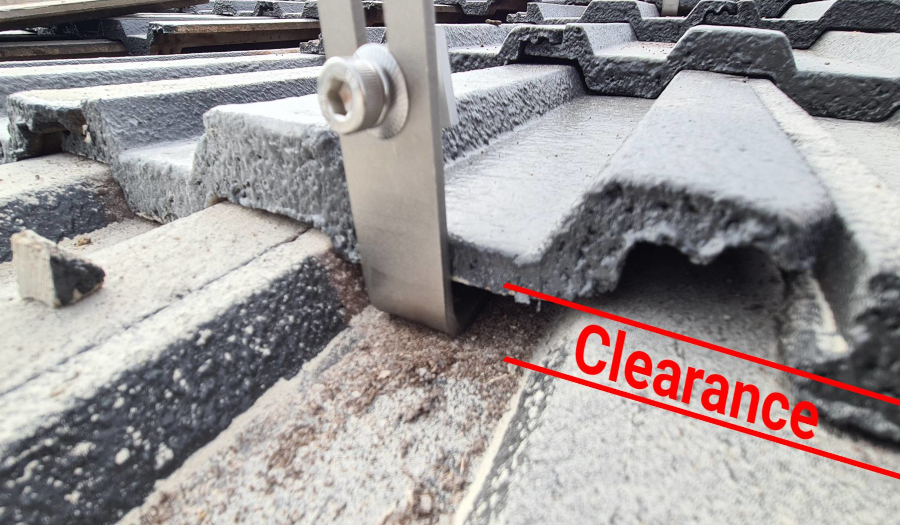
 RSS - Posts
RSS - Posts



I built a house in Sydney 6 years ago. There was a promotion package at the time and part of that was an “upgrade” to a Terracotta tile roof. literally 2 months after we moved in a massive hailstorm came through and damaged hundreds of houses – but ours was so bad that all the tiles (and half the gutters) needed to be replaced.
And then we had a 13kw solar system installed. I felt SO BAD for the installers – the time it took to grind all the tiles, and the number of cracked tiles that occurred.
I honestly don’t know why they’re still allowed to sell Terracotta tiles in Australia. Surely they’re just not “fit for purpose”. I’ll surely never use tiles, regardless of the material, again.
Coreying you’ll appreciate the industry descriptor for them… terror-cotta.
They produce a flight response, many installers just run, with decromatic (tin tile) or asbestos being the only things held in lower regard.
Yep, they’re honestly the single biggest mistake we made when building. As I said, they just are not fit for purpose and they shouldn’t be allowed to sell them. The fact that, as you mentioned, they are not even consistent after being kiln fired means that they don’t all fit together properly anyway, frustrating. Every time we have a heavy rain combined with heavy wind, in the back of your mind you’re worried about when the next leak will appear.
Something that’s not clear to me: while it obviously makes sense for the home owner to have spare tiles on hand for convenience of quick repairs during the solar installation, is it actually their responsibility? If the tile roof is in good condition before the solar installation, why don’t breakages and tile replacement become the solar installer’s problem to solve, including sourcing the tiles?
After all, if a sparky is up in your roof cavity and accidentally puts a foot through the ceiling, they’d be expected to fix that themselves. You wouldn’t expect them to turn to you and ask for your spare gyprock and plaster.
Either way, it makes sense to establish up front whether there are spare tiles in hand, or if the installer needs to find some in advance.
Hi Chris,
To use your analogy, the ceiling in the house isn’t designed to bear weight. I have slipped and nearly fallen through a ceiling before, and that indeed was an installer problem.
However if I had kept my feet to the ceiling joists and one of them broke in half and I crashed through the ceiling because the timber was full of white ants, then it would be a customer problem for having a defective building.
Tiles are just an inherently brittle and in my opinion terrible idea for a roof. I have seen with my own eyes a ceiling that lifted from a new built in kitchen because we had just unloaded the tile roof off the house. You wouldn’t believe that the place stood up 10mm without such excessive weight bearing on it.
The reason that tiles are often left stashed under your house is that they are just a consumable. They can crack and leak for no good reason at all, so walking across them never helps the situation.
However they must be walked on, to fix your aerial, clean gutters, paint a window, maintain a hot water service or indeed install solar. That they really aren’t durable under foot isn’t an installer problem.
Anyone who climbs on the roof is obliged to make sure they don’t cause leaks but supplying replacement tiles, when there are hundreds of designs across decades isn’t something you can expect a service provider to practically do.
Except perhaps if it’s a service company which you have contracted for full building maintenance. They’ll be the ones charging handsomely for the work, subletting the specialised trades and possibly billing you for the tiles you already own.
That’s my understanding of it anyway.
The complicating factor in your position on this Anthony is the degree of care taken by the installer regarding foot placement and installation practices. I have colourbond damaged by the installer standing between timbers rather than on them. If that was tile then it would be tiles causing the problem?
I have scratched colorbond in area where the panels were stacked, dragged, worked on. If it was a tile roof there would likely be broken tiles there, again a fault of the tiles?
Thanks Anthony, those are fair points. I guess then for a consumer it’s reasonable to expect to have to supply a few spare tiles, but also they should pay attention to the installation in progress to make sure that the installer is working carefully to minimise breakages. That’s going to be hard for most home owners to judge though. All the more reason to try to engage a reputable installer!
Great, detailed piece, thank you. We have concrete roof tiles, and had the roof restored pre-solar installation late last year. The restorer was very professional, actually went under the house without me even prompting to find the spare tiles, and had about a dozen of them lined up in a row, pre-painted to the new colour, ready for the solar install (which I’d told them about). The restoration itself needed hardly any new tiles, so they’d survived a few decades without any real damage (they were painted by a previous restore about 20 years ago). I’m guessing painting helps reduce porosity and therefore keeps you from gaining tile weight over the years?
The installers were also superb, and needed hardly any of the spares. But then I did find them through this site. They did say at every stage of quotation through to installation “thank you for not having terracotta tiles”.
Sounds like a very professional roof painter who will benefit from the positive feedback you would leave them.
Your old concrete tiles would be much harder now than when they were first laid. Concrete tiles continue to harden as they age for decades, a positive Anthony omitted.
Yep, gave them an excellent online review. And I had heard that the tiles harden with age, as concrete tends to. One of the reasons I went with a restore, rather than replacement with Colorbond. The restorer said the roof was still in excellent condition.
I think Anthony’s main gripe with them is that they’re harder to install solar on than a metal roof.
Hi Anthony
Good article, as usual. As a building designer/consultant/inspector I always urge clients to try and avoid solar on tiles. I try to look for other locations such as sheds and patios, if available.
This raises a couple of issues:
1. Make sure that the sub-main and board in the shed are suitable for a solar setup, with the low allowable voltage drop. If doing a new job or upgrading, it is little extra material cost to oversize everything just in case. (And it will probably pay off in the future when you buy your new mega welder!)
2. This means that if the job is being done by a non-solar sparky, get them to discuss it with a reputable solar dude to make sure that everything is done properly.
3. This is why I have spent 5 years designing a very simple solar panel system that replaces the roofing entirely, requires no sealants or even tools to install, and costs the same as standard systems (plus cost of removing old roofing), but can’t get anyone in Australia interested….Grrr!!
Keep up the good work!
Bob Tumath
p.s. one very minor criticism on your article – tiles are ceramic so you should really use acetic cure bathroom silicone, rather than the neutral cure roof & gutter types that are meant for metals.
Cheers Bob,
I just don’t get the fascination with tiles but then again my old Irish mate said that “back in the old country it was only the poors that had a tin roof” He didn’t seem to have worked out he was living in Australia now… 😛
Sheds are good for solar, I’ve even written an article on that if you want to do a little search.
Tesla are persevering with BIPV I think, and there was a slick system presented at this year’s all energy conference too but I’ve not heard much more on it either.
Anthony,
One benefit of growing up on a farm has been a preference for a tin roof. We welcomed the sound of rain on it, especially when waiting for its beneficence to arrive. On the new build I used KlipLok 700, so there are no roof penetrations for roof fixing. (Have just replaced hundreds of roofing nails on the 60+ year old roof with gasketted screws.)
In the BAL 19 fire rating zone, no cladding gap of more than 3mm was permitted. I shot for 1mm. Your description of tiles suggests they might be an invitation to unwelcome combustion. Wind driven ember attack can be much more aggressive than we imagine from a safe distance.
There are profile matching PV array mounting clips on the market, so even panels won’t breach the KlipLok. I had imagined perhaps running the PV cables up under the ridge capping, but that 90 degree rule might impede that. (I have 25m of walkway (3 slightly spaced 90×45) under the ridge, but you have to duck your head in there, if you’re tall. And three manholes. Ya can throw tools up one, then climb up another..)
Hi Anthony
We moved into a home that had a concrete tile roof and have had no problems, having installed 30 odd panels over 10 years.
No breakages at all.
In fact, after a hail storm of some ferocity, all the Zincalume or other types of metal roofs in our suburb had to be replaced. They are still being replaced a year after the event.
The only leak in our roof was caused by a replacement TV antennae mount where the screw holes had not been sealed properly.
As regards metal roofs: many years ago, I trained as a carpenter and believe that the modern metal sheeting is too thin.
I used to walk on the old style corrugated iron, along the battens without causing dents.
I swear by my concrete tiles and have no hesitation on walking on my roof.
Having served in the SES making temporary repairs to skylights and roofs damaged by hailstorms and serious rain, I certainly know what type of roof I like. Concrete tile.
Cheers
Bob
Thanks Bob,
If I was king I’d ban tile roofs as a waste of resources but the myriad of other reasons are listed in this article ;
https://www.solarquotes.com.au/blog/roof-tile-problems-solar/
Thankfully it’s simple economics that will drive tiles out of the market.
Cheers
Bob,
Yes, you can use acid-cure silicone on terracotta tiles.
NO, you shouldn’t use acid-cure silicone on cement tiles.
It’s not possible for new silicone to adhere successfully to existing (old) silicone if a repair needs to be done.
Polyurethane can be used successfully on all types of materials and new polyurethane will adhere to old polyurethane if a repair is ever needed.
Is either silicone or polyurethane better? That’s another discussion.
(Note – Silicones and polyurethanes will not adhere is some types of plastics.)
If you have decent tiles they are better than tin roofs any day in my opinion.
Tin roof screws and caps eventually start leaking after a few years of red hot and freezing cold temperatures and then the tin works loose. Then when it rains you’ll have a devil of a job tracing where the leak is coming from. Or worse, the wind will get under the tin and you’ll lose part of your roof in a strong wind. You don’t see tile roofs coming off so easily.
Solar installers may not like them but that’s no reason to diss them. Respect my tiles !!
Great article Anthony,
We live in a small strata building with a slate roof. All our owners are keen to get solar panels installed but there seems to be a reluctance on the part of installers to deal with slate.
Would it be possible for you to write something about how to approach this issue? Resolving the problem by replacing the roof with metal doubles the cost and makes the value proposition very challenging.
Appreciate any help you can offer!
Hi Alistair,
I’ve done tin tiles but slate is a whole new level of difficulty as you might appreciate. As mentioned I like replacing tiles with iron because you can do some other work like properly installed insulation. The expense will climb but the returns will be compounded if you can manage the expense with a green loan perhaps?
I can have a hunt around along with Ned in the comments below. We may even need to go off the farm so to speak and get in contact with some non SQ installers… (just don’t tell Trev the manager OK)
So its not even worth thinking about solar on my 55 year old tiled roof
Hi Chris,
The photos of me drilling tiles with a wet diamond saw are from a house that was by my estimation 70 years old. I can’t remember ever seeing a mustard yellow roof before but it would look dandy compared to the grey snot that abounds everywhere now.
I wouldn’t hesitate to get quotes on a 1960’s vintage house, just be aware that you will likely need tiles for it.
Hi Anthony, can you recommend any installers in Sydney who will instal solar on slate roofs? I am having real difficulty sourcing anyone who will do it.
Hi Sarah
Keen to help you out here – could you e-mail me your postcode? [email protected]
I’ll then ring around the area and try to locate an installer to help and get back to you 🙂
Thanks for getting in touch.
All the photos in this article seem to show the conduit coming out next to the array. Does that mean conduit is not allowed to come out underneath the array (or underneath the ‘footprint’ of any panels)? I would think coming out underneath would be better (less UV exposure and water pressure).
Hi Washingtonia,
Wherever possible we do put roof penetrations under the array, though occasionally something like a firewall inside the building means you need to come out of the roof.
Hi Anthony
Are you able to point me to direct Australian Standard sections that talk about having to grind down tiles so they sit neatly after bracket install. Couldn’t find anything, only recommendations. Getting one of your recommended installers to put in a 13kw system for me next week and just want to be on the front foot. Thanks for the recommendation, local guys and they even came to the party on the price. Im sure all will be fine.
Cheers
Matt
CEC Guidelines V14 (mandatory if you are claiming STCs)
4.1.3 Tiles shall sit flat after the installation of tile mounting brackets to ensure the tiles maintain their
original ingress protection. There may be a requirement to grind the underside of the tile to enable it
to sit correctly.
We had our solar setup installed in August 2023, with the tile installation done “the wrong way”. Every single mounting bracket has lifted 1-2 tiles.
Prior to the solar install the house was nice and comfortable, even in winter – no draughts and minimal heating costs.
Since the solar went up on the roof we now have a draught through the house when the house is closed up.
Should I be able to challenge the installer to have these mount points rectified?
Hi Gregor,
Does the roof have sarking that they might have torn holes in? In any case the tiles must be ground to fit every tile they pass under so that they sit back down exactly where they used to. If they haven’t done this then there’s a clear breach of CEC installation rules and a good case for getting them back to reinstall the whole system.
Thanks Anthony.
The house is an old fashioned brick veneer build. No sarking under the roof tiles and none in the walls.
I’ll take it up with the installer to get it compliant under the CEC installation rules.
Hi Anthony
I recently purchased a 1976 brick home with concrete roof tiles the roof is a simple low pitch roof with sides facing east and west. The building is a rectangle shape built on a north/south slope front faces north. The gutters either side are in average condition but have a few leaky spots due to them prob not being cleaned (lots of gum trees)- I want to put solar panels on asap – and possibly ducted aircon. in time. There is a small car port where panels can be placed too I would need to have the roof renovated but am wondering if its better just to get a new iron roof,and gutters, improve the insulation and ditch the tiles! Quotes for either options of course as to which is more cost effective. You may have an opinion on this. All the homes in this area are of simialr vintage and have either terracota or concrete tiles- most have solar panels and refridgerator air conditioning… so know solar on tiles is absolutely possible but does present as fiddly!
thankyou
Ros
Hi Ros,
We have articles for you, you’re on the right track.
Try these two and three orange text hyperlinks in the text.
https://www.solarquotes.com.au/blog/getting-solar-right-building/
https://www.solarquotes.com.au/blog/roof-tile-problems-solar/